1. Kearney PM, Whelton M, Reynolds K, Muntner P, Whelton PK, He J. Global burden of hypertension: analysis of worldwide data. Lancet. 2005; 365:217–223. PMID:
15652604.

2. Chobanian AV, Bakris GL, Black HR, Cushman WC, Green LA, Izzo JL Jr, Jones DW, Materson BJ, Oparil S, Wright JT Jr, Roccella EJ. National Heart, Lung, and Blood Institute Joint National Committee on Prevention, Detection, Evaluation, and Treatment of High Blood Pressure. National High Blood Pressure Education Program Coordinating Committee. The seventh report of the Joint National Committee on Prevention, Detection, Evaluation, and Treatment of High Blood Pressure: the JNC 7 report. JAMA. 2003; 289:2560–2572. PMID:
12748199.

3. Ministry of Health and Welfare, Korea Centers for Disease Control and Prevention. Korea Health Statistics 2017: Korea National Health and Nutrition Examination Survey (KNHANES VII-2). Cheongju: Korea Centers for Disease Control and Prevention;2018.
4. Karppanen H, Mervaala E. Sodium intake and hypertension. Prog Cardiovasc Dis. 2006; 49:59–75. PMID:
17046432.

5. Adrogué HJ, Madias NE. Sodium and potassium in the pathogenesis of hypertension. N Engl J Med. 2007; 356:1966–1978. PMID:
17494929.

6. Cappuccio FP, Kalaitzidis R, Duneclift S, Eastwood JB. Unravelling the links between calcium excretion, salt intake, hypertension, kidney stones and bone metabolism. J Nephrol. 2000; 13:169–177. PMID:
10928292.
7. Blaustein MP, Hamlyn JM. Pathogenesis of essential hypertension. A link between dietary salt and high blood pressure. Hypertension. 1991; 18:III184–95. PMID:
1937683.

8. Binia A, Jaeger J, Hu Y, Singh A, Zimmermann D. Daily potassium intake and sodium-to-potassium ratio in the reduction of blood pressure: a meta-analysis of randomized controlled trials. J Hypertens. 2015; 33:1509–1520. PMID:
26039623.
9. Houston MC. The importance of potassium in managing hypertension. Curr Hypertens Rep. 2011; 13:309–317. PMID:
21403995.

10. Yim KS. The effects of a nutrition education program for hypertensive female elderly at the public health center. Korean J Community Nutr. 2008; 13:640–652.
11. Moon EH, Kim KW. Evaluation of nutrition education for hypertension patients aged 50 years and over. Korean J Community Nutr. 2011; 16:62–74.

12. Kim HH, Shin EK, Lee HJ, Lee NH, Chun BY, Ahn MY, Lee YK. Evaluation of the effectiveness of a salt reduction program for employees. Korean J Nutr. 2009; 42:350–357.

13. Son SM, Kim MJ. The effect of nutrition education program for various chronic disease in elderly visiting public health center. Korean J Community Nutr. 2001; 6:668–677.
14. Park SY, Kwon JS, Kim HK. Effect of a public health center-based nutrition education program for hypertension in women older than 50 years of age. J Nutr Health. 2018; 51:228–241.

15. Sim JH. The Effects of Diet Health Education Program for Prehypertension Group on the Diet Habit and Blood Pressure. J Korean Soc Health Educ Promot. 2006; 23:1–12.
16. Moshfegh A, Goldman J, Cleveland L. What We Eat in America, NHANES 2001–2002: Usual Nutrient Intakes from Food Compared to Dietary Reference Intakes. Washington, D.C.: U.S. Department of Agriculture, Agricultural Research Service;2005.
17. Son SM, Huh GY, Lee HS. Development and Evaluation of Validity of Dish Frequency Questionnaire (DFQ) and Short DFQ Using Na Index for Estimation of Habitual Sodium Intake. Korean J Community Nutr. 2005; 10:677–692.
18. Son SM. Pilot Study for Low Salt Consumption Projects for Korean People. Seoul: Ministry of Health & Welfare;2006.
19. Yoon JS. Developing Nutrition Education model for Reducing Sodium Intake and Evaluation. Daegu: Keimyung University Industry-Academic Cooperation Foundation;2011.
20. Rhee MY. Sodium Intake: Research for the Improvement in Measurement Methods and the Effect of Sodium Intake on Cardiovascular Health. Seoul: Dongguk University Industry-Academic Cooperation Foundation;2011.
21. Ard JD, Svetkey LP. Diet and blood pressure: applying the evidence to clinical practice. Am Heart J. 2005; 149:804–812. PMID:
15894960.

22. Mattes RD. The taste for salt in humans. Am J Clin Nutr. 1997; 65:692S–697S. PMID:
9022567.

23. Jung EJ, Kwon JS, Ahn SH, Son SM. Blood pressure, sodium intake and dietary behavior changes by session attendance on salt reduction education program for pre-hypertensive adults in a public health center. Korean J Community Nutr. 2013; 18:626–643.

24. Obarzanek E, Sacks FM, Vollmer WM, Bray GA, Miller ER 3rd, Lin PH, Karanja NM, Most-Windhauser MM, Moore TJ, Swain JF, Bales CW, Proschan MA. DASH Research Group. Effects on blood lipids of a blood pressure-lowering diet: the Dietary Approaches to Stop Hypertension (DASH) trial. Am J Clin Nutr. 2001; 74:80–89. PMID:
11451721.
25. Juraschek SP, Miller ER 3rd, Weaver CM, Appel LJ. Effects of sodium reduction and the DASH diet in relation to baseline blood pressure. J Am Coll Cardiol. 2017; 70:2841–2848. PMID:
29141784.
26. Appel LJ, Moore TJ, Obarzanek E, Vollmer WM, Svetkey LP, Sacks FM, Bray GA, Vogt TM, Cutler JA, Windhauser MM, Lin PH, Karanja N, Simons-Morton D, McCullough M, Swain J, Steele P, Evans MA, Miller ER, Harsha DW. DASH Collaborative Research Group. A clinical trial of the effects of dietary patterns on blood pressure. N Engl J Med. 1997; 336:1117–1124. PMID:
9099655.

27. Sacks FM, Svetkey LP, Vollmer WM, Appel LJ, Bray GA, Harsha D, Obarzanek E, Conlin PR, Miller ER 3rd, Simons-Morton DG, Karanja N, Lin PH, Aickin M, Most-Windhauser MM, Moore TJ, Proschan MA, Cutler JA. DASH-Sodium Collaborative Research Group. Effects on blood pressure of reduced dietary sodium and the Dietary Approaches to Stop Hypertension (DASH) diet. N Engl J Med. 2001; 344:3–10. PMID:
11136953.

28. Suter PM, Sierro C, Vetter W. Nutritional factors in the control of blood pressure and hypertension. Nutr Clin Care. 2002; 5:9–19. PMID:
12134718.

29. Aburto NJ, Hanson S, Gutierrez H, Hooper L, Elliott P, Cappuccio FP. Effect of increased potassium intake on cardiovascular risk factors and disease: systematic review and meta-analyses. BMJ. 2013; 346:f1378. PMID:
23558164.

30. Yon M, Lee Y, Kim D, Lee J, Koh E, Nam E, Shin H, Kang B, Kim JW, Heo S, Cho H, Kim C. Major sources of sodium intake of the Korean population at prepared dish level - based on the KNHANES 2008 & 2009 -. Korean J Community Nutr. 2011; 16:473–487.
31. Kim HH, Lee YK. Analysis of presumed sodium intake of office workers using 24-hour urine analysis and correlation matrix between variables. Korean J Nutr. 2013; 46:26–33.

32. Park YH, Chung SJ. A Comparison of sources of sodium and potassium intake by gender, age and regions in Koreans: Korea National Health and Nutrition Examination Survey (KNHANES) 2010–2012. Korean J Community Nutr. 2016; 21:558–573.

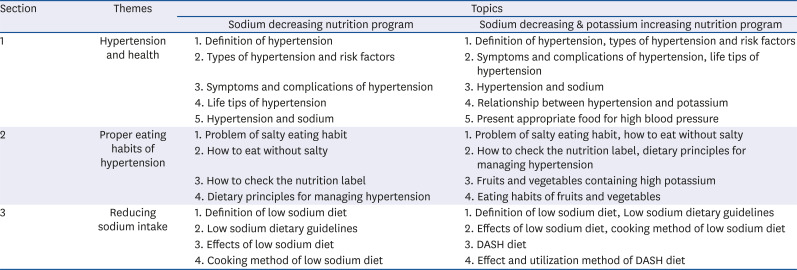
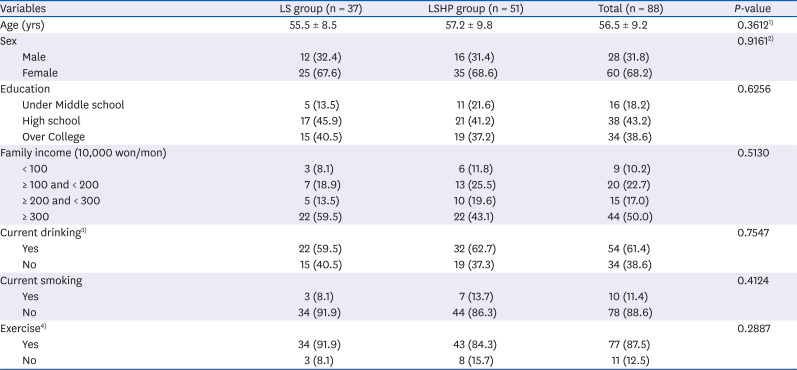
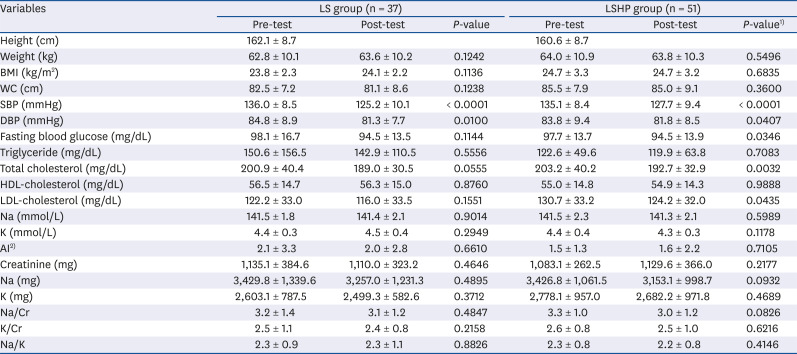
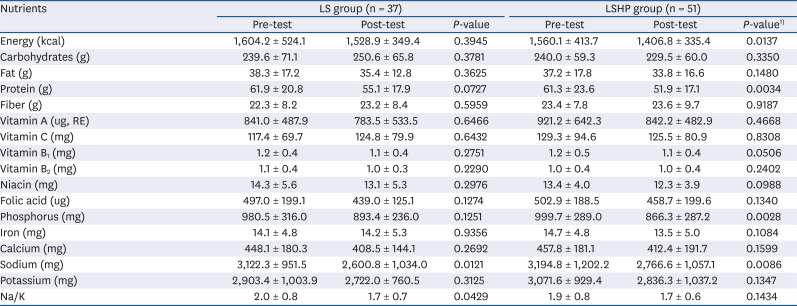

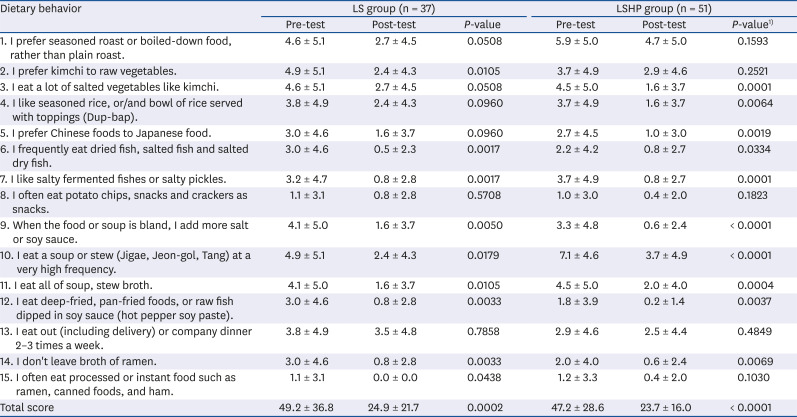




 PDF
PDF Citation
Citation Print
Print




 XML Download
XML Download